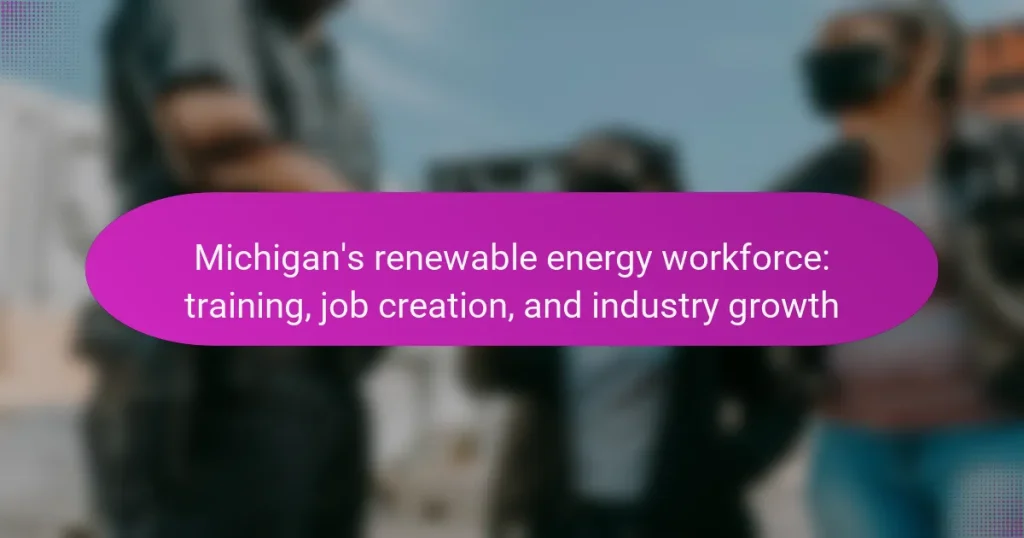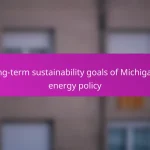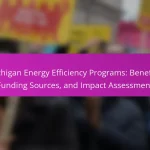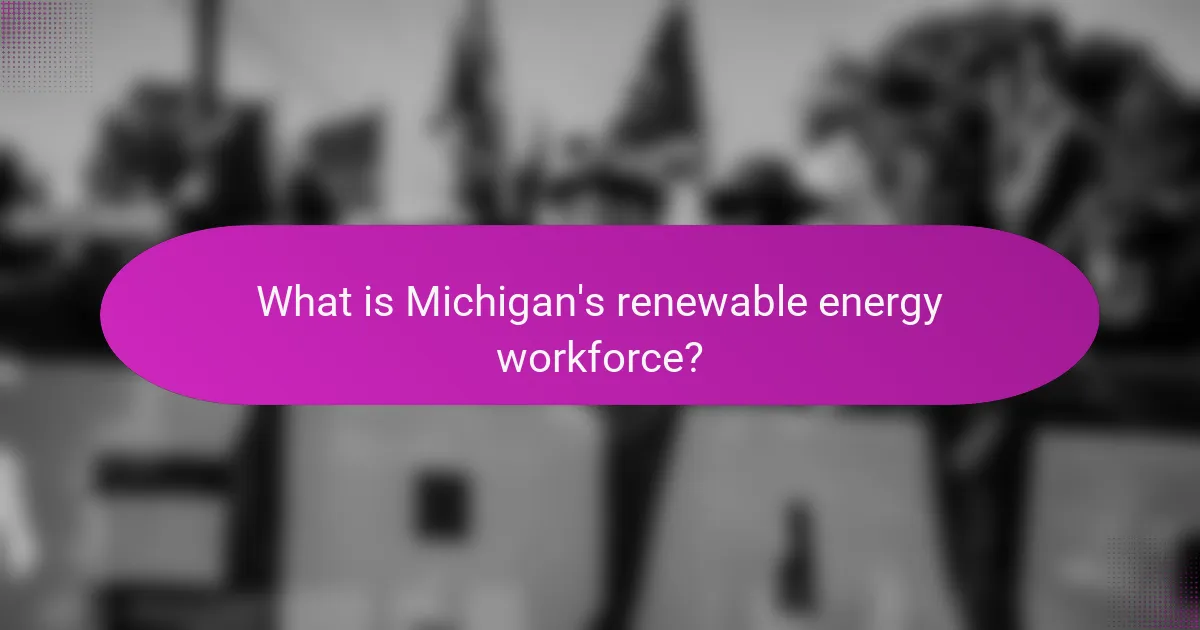
What is Michigan’s renewable energy workforce?
Michigan’s renewable energy workforce comprises professionals engaged in the development, installation, and maintenance of renewable energy technologies. This workforce includes roles in solar, wind, and biomass energy sectors. As of 2021, Michigan’s renewable energy sector employed approximately 90,000 workers. The state aims to increase renewable energy production to 50% by 2030. This goal is expected to create thousands of additional jobs. Training programs are available to equip individuals with necessary skills. These programs focus on technical expertise and safety standards. The workforce is supported by state policies promoting clean energy initiatives.
How has the renewable energy sector evolved in Michigan?
The renewable energy sector in Michigan has significantly evolved over the past decade. The state has increased its renewable energy capacity, primarily through wind and solar energy. As of 2022, Michigan generated over 15% of its electricity from renewable sources. The state has also set ambitious goals to reach 50% renewable energy by 2030.
This growth is supported by various policies and incentives, including the Clean and Renewable Energy Standard. Additionally, Michigan’s workforce in the renewable energy sector has expanded, creating thousands of jobs. The Michigan Energy Innovation Business Council reported over 100,000 jobs in the clean energy sector in 2021.
Investments in renewable energy projects have surged, with over $2 billion invested in wind and solar farms from 2010 to 2020. These developments have positioned Michigan as a leader in renewable energy within the Midwest region.
What key milestones have shaped Michigan’s renewable energy landscape?
Michigan’s renewable energy landscape has been shaped by several key milestones. The 2008 Energy Reform Act established a renewable portfolio standard, requiring utilities to obtain 10% of their energy from renewable sources by 2015. In 2016, Governor Snyder signed legislation increasing the standard to 15% by 2021. The 2019 Clean Energy Plan set ambitious goals for 25% renewable energy by 2030 and 50% by 2040. Additionally, the state has invested in wind and solar projects, significantly increasing capacity. By 2021, Michigan was ranked 10th in the nation for installed wind capacity. These milestones have fostered job creation and workforce development in the renewable sector.
How do state policies impact the renewable energy workforce?
State policies significantly influence the renewable energy workforce by shaping regulations and incentives. These policies can encourage investment in renewable energy projects. For example, tax credits and subsidies can lower the cost of solar and wind energy installations. When states set renewable portfolio standards, they mandate a certain percentage of energy from renewable sources. This creates job opportunities in installation, maintenance, and manufacturing sectors. According to the U.S. Bureau of Labor Statistics, jobs in renewable energy are expected to grow by 11% from 2018 to 2028. In Michigan, the Clean and Renewable Energy Act supports workforce development initiatives. This ensures that workers are trained in the skills needed for the evolving energy landscape.
Why is the renewable energy workforce important for Michigan’s economy?
The renewable energy workforce is crucial for Michigan’s economy because it drives job creation and industry growth. This sector has the potential to generate over 60,000 jobs by 2025. Renewable energy investments contribute significantly to local economies. For instance, wind and solar projects enhance energy independence and reduce utility costs. Additionally, Michigan’s focus on clean energy attracts businesses and fosters innovation. The state aims for 50% renewable energy by 2030, promoting sustainable practices. This transition not only supports environmental goals but also stimulates economic development.
What role does job creation play in Michigan’s renewable energy initiatives?
Job creation is a crucial component of Michigan’s renewable energy initiatives. It drives economic growth and supports the transition to sustainable energy sources. The renewable energy sector in Michigan has created thousands of jobs in recent years. According to the Michigan Energy Innovation Business Council, the state saw a 50% increase in clean energy jobs from 2015 to 2020. These jobs span various fields, including manufacturing, installation, and maintenance of renewable energy technologies. Additionally, job creation in this sector contributes to local economies and supports workforce development programs. Investments in renewable energy also attract further business opportunities, reinforcing job growth. Overall, job creation enhances Michigan’s competitiveness in the renewable energy market.
How does the renewable energy workforce contribute to local communities?
The renewable energy workforce contributes to local communities by creating jobs and stimulating local economies. This workforce includes technicians, engineers, and support staff who work in solar, wind, and other renewable sectors. According to the U.S. Department of Energy, renewable energy jobs grew by 11% in Michigan from 2018 to 2019. These jobs often pay higher wages than traditional energy jobs, which boosts local spending power. Additionally, local businesses benefit from increased demand for services and products related to renewable energy projects. Community investment in renewable energy can also lead to improved infrastructure and energy independence.
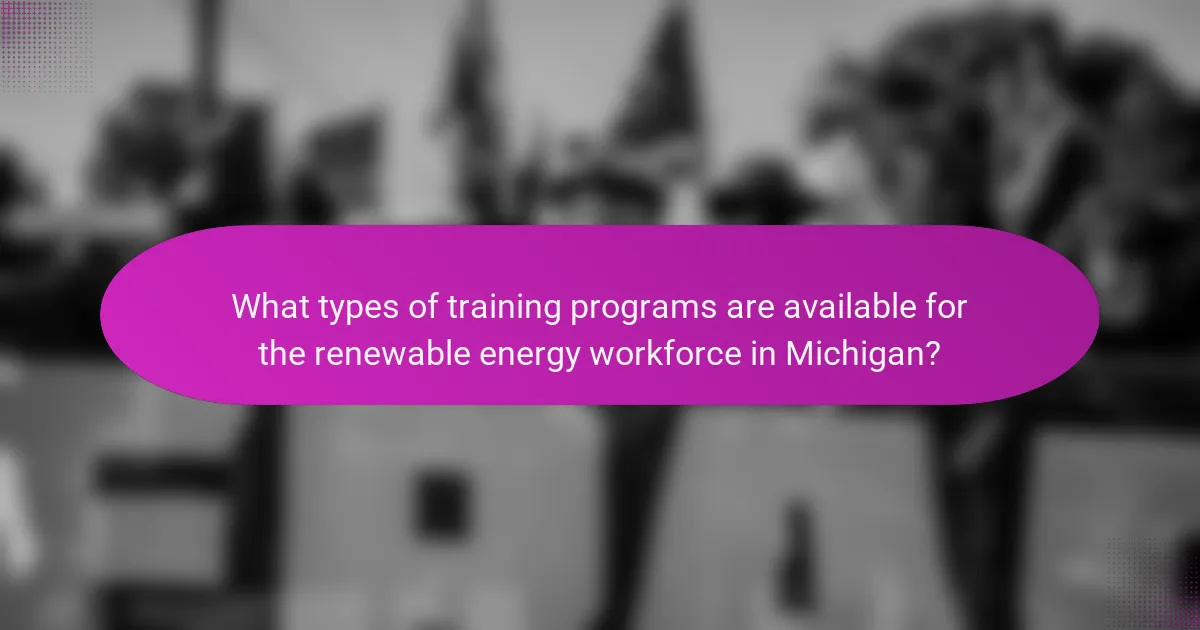
What types of training programs are available for the renewable energy workforce in Michigan?
Michigan offers various training programs for the renewable energy workforce. These programs include vocational training, apprenticeships, and degree programs. Vocational training focuses on specific skills for solar and wind energy installation. Apprenticeships provide hands-on experience in the field while earning a wage. Degree programs are available at community colleges and universities, covering broader energy topics. Notable institutions like Michigan State University and Ferris State University offer relevant degrees. The Michigan Energy Workforce Development Program supports these initiatives by connecting training with industry needs. These programs collectively aim to enhance workforce readiness in the growing renewable energy sector.
How do educational institutions contribute to workforce training?
Educational institutions contribute to workforce training by providing specialized programs and curricula tailored to industry needs. They offer degrees and certifications in renewable energy technologies. These programs equip students with essential skills for jobs in the sector. Many institutions partner with local businesses for internships and hands-on training. This collaboration ensures students gain real-world experience. Research from the Michigan Energy Innovation Business Council shows that these initiatives increase employability. Furthermore, educational institutions often conduct research that drives innovation in renewable energy. This research contributes to the development of new technologies and practices in the industry.
What specific programs are offered by universities and colleges?
Universities and colleges in Michigan offer various programs focused on renewable energy. These include degrees in Renewable Energy Engineering, Environmental Science, and Sustainability Studies. Many institutions provide certificates in Solar Energy Technology and Wind Energy Management. Programs often incorporate hands-on training and internships in local renewable energy projects. For example, Michigan State University has a Renewable Energy Certificate program. Additionally, community colleges offer associate degrees in Energy Technology. These programs aim to equip students with skills for the growing renewable energy job market in Michigan.
How do vocational training centers support renewable energy skills development?
Vocational training centers support renewable energy skills development by providing specialized training programs. These programs focus on essential skills such as solar panel installation, wind turbine maintenance, and energy efficiency practices. Training centers often collaborate with industry partners to ensure that curricula align with current job market needs. This collaboration helps students gain practical experience through internships and hands-on projects. According to the Michigan Energy Innovation Business Council, the state aims to create 50,000 jobs in the renewable energy sector by 2030. Vocational training centers play a crucial role in preparing the workforce to meet this demand. They also help reduce the skills gap in the renewable energy industry, ensuring a steady supply of qualified workers.
What certifications are important for professionals in the renewable energy sector?
Key certifications for professionals in the renewable energy sector include the NABCEP Solar PV Installer Certification, which validates expertise in solar energy systems. The RESNET HERS Rater Certification focuses on energy efficiency in residential buildings. The LEED Green Associate credential demonstrates knowledge of sustainable building practices. The Wind Turbine Technician Certification shows proficiency in wind energy technology. Additionally, the Certified Energy Manager (CEM) designation covers comprehensive energy management strategies. These certifications enhance employability and ensure adherence to industry standards.
Which organizations provide these certifications?
The organizations that provide certifications in Michigan’s renewable energy sector include the Michigan Energy Workforce Development Consortium, the Michigan Department of Licensing and Regulatory Affairs, and various community colleges. These organizations focus on training and certifying individuals for jobs in renewable energy. The Michigan Energy Workforce Development Consortium collaborates with industry leaders to create relevant certification programs. The Michigan Department of Licensing and Regulatory Affairs oversees the licensing process for renewable energy professionals. Community colleges offer programs that align with industry standards and provide hands-on training.
How do certifications enhance job prospects for workers?
Certifications enhance job prospects for workers by validating their skills and knowledge in specific fields. They demonstrate a commitment to professional development. Employers often prefer certified candidates over non-certified ones. This preference can lead to increased job opportunities. According to a report by the Bureau of Labor Statistics, certified workers typically earn higher salaries. Certifications can also provide a competitive edge in a crowded job market. In Michigan’s renewable energy sector, certifications are crucial for roles in solar and wind energy. They signify expertise in emerging technologies, making candidates more attractive to employers.
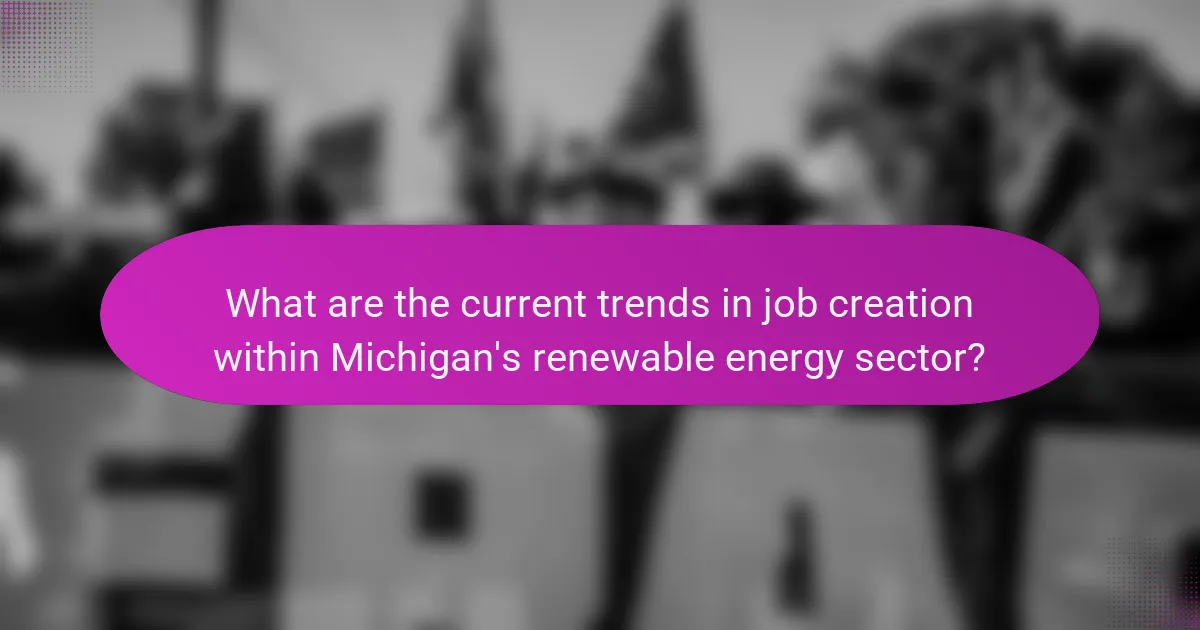
What are the current trends in job creation within Michigan’s renewable energy sector?
Michigan’s renewable energy sector is experiencing significant job creation trends. The state has seen an increase in jobs related to wind and solar energy installations. In 2022, Michigan added over 3,000 renewable energy jobs, reflecting a growing demand for clean energy solutions. The Michigan Energy Innovation Business Council reported a 10% growth in the clean energy workforce. This growth is driven by state policies promoting renewable energy and investments in green technologies. Additionally, the transition to electric vehicles is creating new opportunities in battery manufacturing and infrastructure. The trend indicates a shift toward sustainable energy sources and a commitment to reducing carbon emissions.
Which renewable energy fields are experiencing the most growth?
Solar energy and wind energy are experiencing the most growth in renewable energy fields. Solar energy installations have increased significantly, with a reported growth rate of over 20% annually in recent years. Wind energy capacity has also expanded, with new installations adding approximately 10 gigawatts in 2022 alone. Both sectors benefit from technological advancements and decreasing costs. According to the U.S. Energy Information Administration, renewable energy sources are projected to contribute about 50% of the total electricity generation by 2050. This growth reflects a broader shift towards sustainable energy solutions.
What types of jobs are being created in solar energy?
Solar energy is creating a variety of jobs across multiple sectors. Key roles include solar panel installers, who are essential for setting up solar energy systems. There are also positions for solar engineers, responsible for designing solar technologies. Project managers oversee solar projects from inception to completion. Sales representatives are needed to promote solar products to consumers and businesses. Additionally, maintenance technicians ensure the ongoing functionality of solar installations. According to the Solar Foundation’s National Solar Jobs Census, the solar industry employed over 250,000 workers in the U.S. in 2019, highlighting significant job creation in this sector.
How is the wind energy sector contributing to job opportunities?
The wind energy sector is significantly contributing to job opportunities in Michigan. This sector has created thousands of jobs in manufacturing, installation, and maintenance of wind turbines. According to the U.S. Department of Energy, the wind industry supported over 100,000 jobs nationwide in 2020. Michigan’s wind energy projects have led to local job creation in rural areas, boosting regional economies. The state has also invested in training programs to equip workers with necessary skills. These programs help ensure a workforce ready to meet industry demands. Overall, the growth of the wind energy sector is a key driver of employment in Michigan.
What challenges does the renewable energy workforce face in Michigan?
The renewable energy workforce in Michigan faces several challenges. One significant challenge is the skills gap among workers. Many existing workers lack the necessary training for advanced renewable technologies. Additionally, there is a shortage of skilled labor in the industry. This shortage hampers the growth of renewable energy projects. Financial constraints also pose a challenge, as funding for training programs is often limited. Furthermore, regulatory hurdles can slow down project implementation. These challenges can affect job creation and industry growth in Michigan’s renewable energy sector.
How do economic fluctuations impact job stability in the sector?
Economic fluctuations significantly impact job stability in Michigan’s renewable energy sector. During economic downturns, funding for renewable energy projects often decreases. This leads to reduced hiring and potential layoffs within the industry. Conversely, during economic upturns, investment in renewable energy typically increases. This can result in job creation and greater job security for workers. A report by the U.S. Department of Energy indicates that renewable energy jobs grew by 11% in 2019 as investments rose. Thus, the stability of jobs in this sector is closely tied to the broader economic climate.
What skills gaps exist within the current workforce?
The current workforce in Michigan’s renewable energy sector faces significant skills gaps. Many workers lack expertise in advanced technologies such as solar and wind energy systems. There is also a shortage of knowledge in energy efficiency practices and sustainable building techniques. Additionally, project management skills specific to renewable energy projects are often insufficient. A study by the Michigan Energy Workforce Development Initiative highlights these gaps, indicating that 70% of employers report difficulty finding qualified candidates. This shortage hampers the growth of the renewable energy industry in the state.
What best practices can enhance the effectiveness of Michigan’s renewable energy workforce?
Investing in comprehensive training programs can enhance the effectiveness of Michigan’s renewable energy workforce. These programs should focus on both technical skills and soft skills. Collaboration with local universities and vocational schools can ensure curriculum relevance. Offering apprenticeships can provide hands-on experience. Regularly updating training materials to reflect industry advancements is crucial. Creating partnerships with renewable energy companies can facilitate job placements. Additionally, promoting diversity in recruitment can expand the talent pool. According to the Michigan Energy Innovation Business Council, a skilled workforce is essential for meeting the state’s clean energy goals.
Michigan’s renewable energy workforce is comprised of professionals involved in the development, installation, and maintenance of renewable energy technologies, including solar, wind, and biomass sectors. As of 2021, this workforce employed approximately 90,000 individuals, with projections for growth driven by state policies aiming for 50% renewable energy production by 2030. The article explores the evolution of this sector, key milestones, the impact of state policies, job creation trends, training programs, and the challenges faced by the workforce. Additionally, it highlights the role of educational institutions and certifications in enhancing job prospects within Michigan’s renewable energy landscape.
